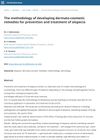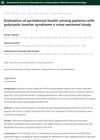Search
for
Sort by
Research
330-360 / 1000+ results
research Antiandrogenic Activity of Riboflavin 5′-Phosphate (FMN) in 22Rv1 and LNCaP Human Prostate Cancer Cell Lines
Riboflavin 5′-phosphate (FMN) shows potential for treating androgen-related conditions but may be limited in treating prostate cancer.

research Post-Finasteride Syndrome and Post-SSRI Sexual Dysfunction: Two Clinically Similar Conditions
Some people experience lasting sexual, psychological, and sleep problems after using finasteride or SSRI antidepressants, possibly due to similar underlying causes.

research High Migratory Activity of Dermal Sheath Cup Cells and Clinical Efficacy in Autologous Therapy for Hair Loss
Cells that move well may improve hair loss treatments by entering hair follicles.

research Hormone Replacement Therapy and COVID-19 Outcomes in Solid Organ Transplant Recipients Compared With the General Population
Hormone replacement therapy may lower the risk of severe COVID-19 outcomes in non-immunosuppressed people and male organ transplant recipients.

research Investigation of Follicle Stimulating Effect of Medical Cosmetic Remedies on the Androgen Alopecia Model in Rats
The cream-mask and gel-mask with certain plant extracts improved hair growth in rats similar to a common hair growth treatment.

research Alteration in Asbabe-Sitta-Zaruriyah (Six Essential Prerequisites for Maintaining Health) to Prevent Intithar al-Sha‘r (Telogen Effluvium): An Insight
Changing six essential health practices can help prevent excessive hair shedding.

research The Methodology of Developing Dermato-Cosmetic Remedies for Prevention and Treatment of Alopecia
New natural remedies for hair loss prevention and treatment were developed.
research Low-Level Laser Therapy in Androgenetic Alopecia: Narrative Review
Low-level laser therapy is a safe and effective treatment for hair loss.
research A Randomized Trial of 5% Minoxidil Versus Combination of 5% Minoxidil and Oral Spironolactone in Treatment of Female Pattern Hair Loss
Combining minoxidil and spironolactone is more effective for female hair loss, but minoxidil alone is sufficient after 6 months.

research The Modern Treatment of Androgenetic Alopecia
Hair loss can be treated with common methods like minoxidil and finasteride, but new potential treatments include growth factors, cytokines, and platelet-rich plasma injections.

research Immunohistochemical Evaluation of Androgen Receptor and Nerve Structure Density in Human Prepuce from Patients with Persistent Sexual Side Effects after Finasteride Use for Androgenetic Alopecia
Finasteride, a hair loss drug, may cause long-term sexual side effects due to changes in hormone receptor levels.

research Gender Identity and Transition: Relationships With Sleep Disorders in US Youth
Transgender youth have more sleep disorders, but gender-affirming therapy may help reduce them.
research Hormonal Control of Vas Deferens Fluid Volume and Aquaporin Expression in Rats
Testosterone increases fluid secretion and aquaporin expression in the vas deferens, which is important for male fertility.

research The Clinical Management of Testosterone Replacement Therapy in Postmenopausal Women with Hypoactive Sexual Desire Disorder: A Review
Testosterone Replacement Therapy can improve sexual health in postmenopausal women with low sexual desire, but more research is needed on its long-term effects.

research Evaluation of the Relationship Between Serum G Protein-Coupled Estrogen Receptors (GPER-1) Levels and the Severity and Duration of the Disease in Patients with Androgenetic Alopecia: A Case-Control Study
Higher GPER-1 levels are linked to more severe and shorter-duration androgenetic alopecia, suggesting GPER-1 as a potential treatment target.

research Female Pattern Hair Loss: An Overview with Focus on the Genetics
Different genes cause Female Pattern Hair Loss compared to male hair loss, and treatments vary, but more research is needed to understand it fully.

research The Influence of ESR1 Polymorphisms on Hormonal, Metabolic, and Mineral Balance Markers in Women with Hyperandrogenism
Certain ESR1 gene variations may affect hormone levels and fat distribution in women with high male hormone levels.
research Visualizing Androgen Receptor Activity in Male and Female Mice
Androgen receptors are active in many tissues of both male and female mice, not just reproductive organs.
research Intracrine and Myotrophic Roles of 5α-Reductase and Androgens
Muscles can make their own androgens, which may help muscle growth.
research A Long-Term Follow-Up Study of Men Born with Very Low Birth Weight and Their Reproductive Hormone Profile
Men born very underweight had higher estrogen levels but normal reproduction compared to normal birth weight men.

research The Mechanisms of Anabolic Steroids, Selective Androgen Receptor Modulators, and Myostatin Inhibitors
Anabolic steroids boost muscle growth, SARMs increase muscle mass and bone density without side effects, and myostatin inhibitors block a protein that stops muscle growth, but each has potential risks.

research The Predictive Value of Midscalp Hair Density and Terminal Hair Percentage in the Severity Evaluation of Female Pattern Hair Loss Assessed by Trichoscan in a Sample of Chinese Population
Midscalp hair density and terminal hair percentage are good indicators of female pattern hair loss severity.
research Hormonal and Genetic Etiology of Male Androgenetic Alopecia

research The Role of Androgens in Androgenetic Alopecia Associated with the Severity of COVID-19
Androgens play a key role in causing alopecia by changing the hair growth cycle.

research Evaluation of Periodontal Health Among Patients With Polycystic Ovarian Syndrome: A Cross-Sectional Study
Women with newly diagnosed PCOS may have worse gum health than those treated for PCOS.
research Managing the PCOS-Related Symptoms of Hirsutism, Acne, and Female Pattern Hair Loss

research Androgen Insufficiency in Women: Diagnostic and Therapeutic Implications
Testosterone replacement can help women with low libido and mood, but they need to have enough estrogen first to avoid side effects.

research Female Pattern Alopecia: Current Perspectives
Female pattern hair loss is caused by multiple factors and while treatments like topical minoxidil, hormone therapy, and low-level light therapy can help, none can fully cure it.
research Anabolic Effects of Testosterone Are Preserved During Inhibition of 5α-Reductase
Testosterone can build muscle and bone without enlarging the prostate when a specific enzyme is blocked.